Leadership and Management in Early Childhood
VerifiedAdded on 2022/11/09
|8
|2200
|224
AI Summary
This assignment discusses the conceptualization of current leadership in the service, conflict resolution principles, team building and motivational leadership, financial management principles and practices, change management and continuous improvement principles and practices, and staff recruitment and retention in early childhood. It also highlights the case scenario of “Bright Little Stars” and the conceptualization of the theories, models and the style of leadership.
Contribute Materials
Your contribution can guide someone’s learning journey. Share your
documents today.
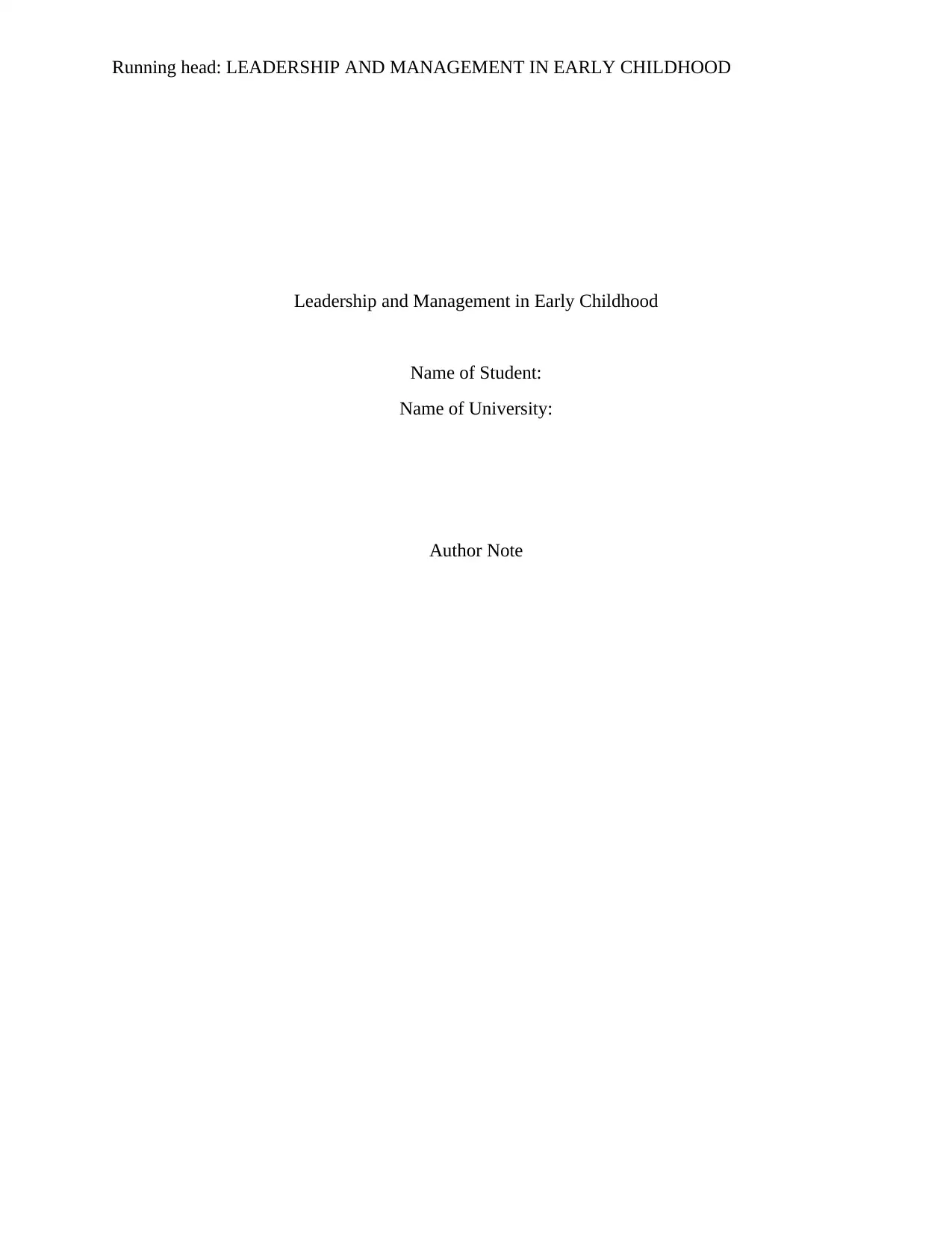
Running head: LEADERSHIP AND MANAGEMENT IN EARLY CHILDHOOD
Leadership and Management in Early Childhood
Name of Student:
Name of University:
Author Note
Leadership and Management in Early Childhood
Name of Student:
Name of University:
Author Note
Secure Best Marks with AI Grader
Need help grading? Try our AI Grader for instant feedback on your assignments.
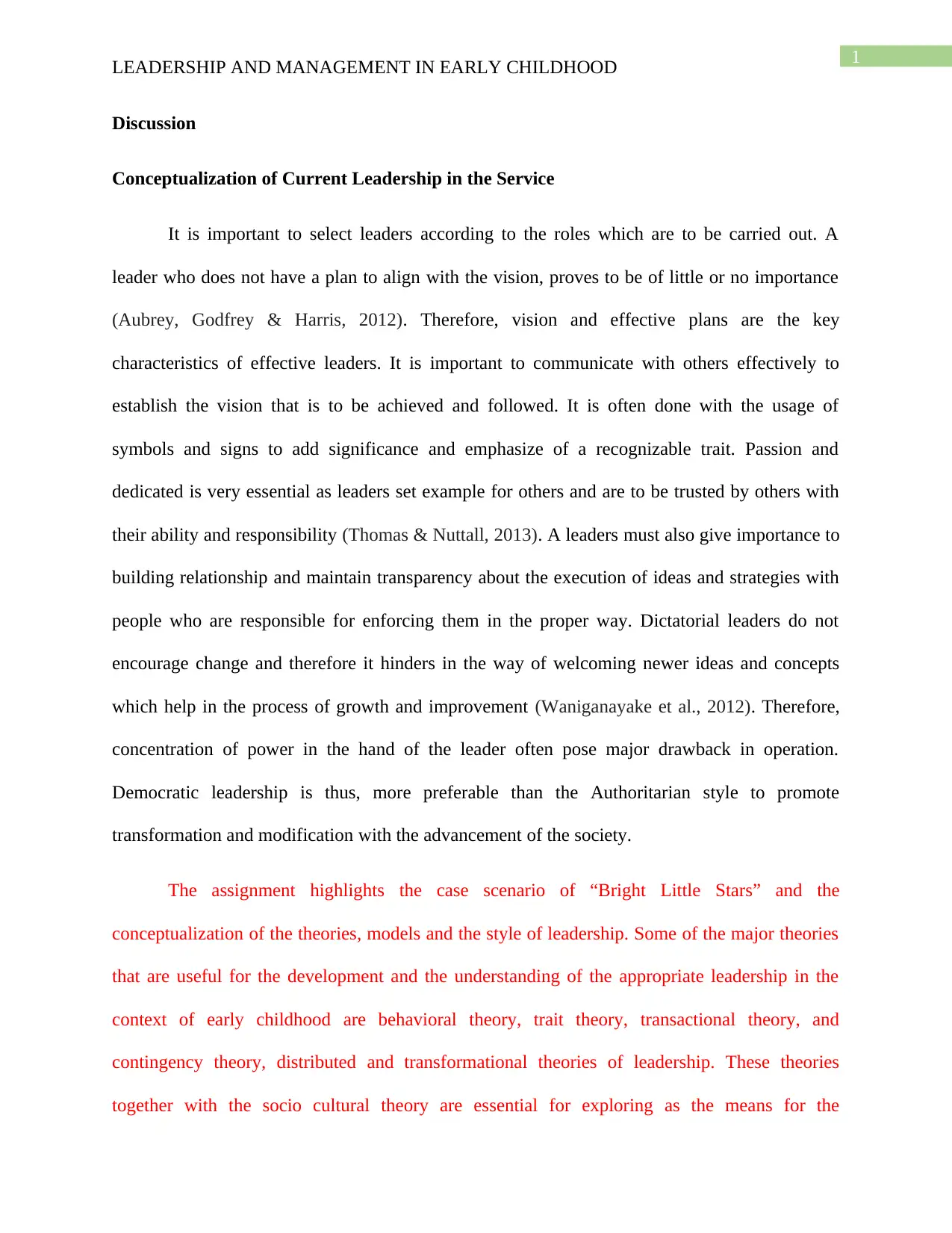
1
LEADERSHIP AND MANAGEMENT IN EARLY CHILDHOOD
Discussion
Conceptualization of Current Leadership in the Service
It is important to select leaders according to the roles which are to be carried out. A
leader who does not have a plan to align with the vision, proves to be of little or no importance
(Aubrey, Godfrey & Harris, 2012). Therefore, vision and effective plans are the key
characteristics of effective leaders. It is important to communicate with others effectively to
establish the vision that is to be achieved and followed. It is often done with the usage of
symbols and signs to add significance and emphasize of a recognizable trait. Passion and
dedicated is very essential as leaders set example for others and are to be trusted by others with
their ability and responsibility (Thomas & Nuttall, 2013). A leaders must also give importance to
building relationship and maintain transparency about the execution of ideas and strategies with
people who are responsible for enforcing them in the proper way. Dictatorial leaders do not
encourage change and therefore it hinders in the way of welcoming newer ideas and concepts
which help in the process of growth and improvement (Waniganayake et al., 2012). Therefore,
concentration of power in the hand of the leader often pose major drawback in operation.
Democratic leadership is thus, more preferable than the Authoritarian style to promote
transformation and modification with the advancement of the society.
The assignment highlights the case scenario of “Bright Little Stars” and the
conceptualization of the theories, models and the style of leadership. Some of the major theories
that are useful for the development and the understanding of the appropriate leadership in the
context of early childhood are behavioral theory, trait theory, transactional theory, and
contingency theory, distributed and transformational theories of leadership. These theories
together with the socio cultural theory are essential for exploring as the means for the
LEADERSHIP AND MANAGEMENT IN EARLY CHILDHOOD
Discussion
Conceptualization of Current Leadership in the Service
It is important to select leaders according to the roles which are to be carried out. A
leader who does not have a plan to align with the vision, proves to be of little or no importance
(Aubrey, Godfrey & Harris, 2012). Therefore, vision and effective plans are the key
characteristics of effective leaders. It is important to communicate with others effectively to
establish the vision that is to be achieved and followed. It is often done with the usage of
symbols and signs to add significance and emphasize of a recognizable trait. Passion and
dedicated is very essential as leaders set example for others and are to be trusted by others with
their ability and responsibility (Thomas & Nuttall, 2013). A leaders must also give importance to
building relationship and maintain transparency about the execution of ideas and strategies with
people who are responsible for enforcing them in the proper way. Dictatorial leaders do not
encourage change and therefore it hinders in the way of welcoming newer ideas and concepts
which help in the process of growth and improvement (Waniganayake et al., 2012). Therefore,
concentration of power in the hand of the leader often pose major drawback in operation.
Democratic leadership is thus, more preferable than the Authoritarian style to promote
transformation and modification with the advancement of the society.
The assignment highlights the case scenario of “Bright Little Stars” and the
conceptualization of the theories, models and the style of leadership. Some of the major theories
that are useful for the development and the understanding of the appropriate leadership in the
context of early childhood are behavioral theory, trait theory, transactional theory, and
contingency theory, distributed and transformational theories of leadership. These theories
together with the socio cultural theory are essential for exploring as the means for the
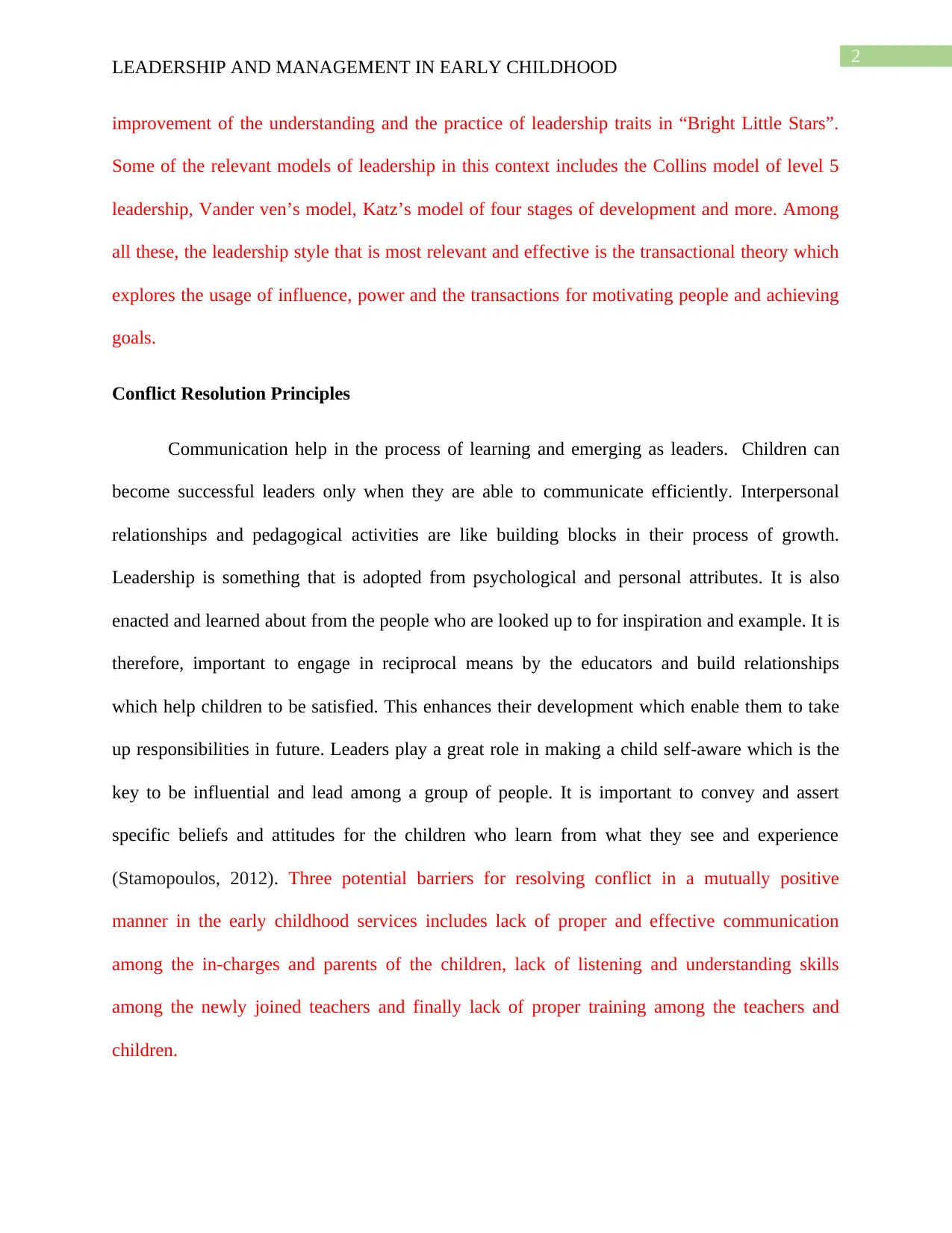
2
LEADERSHIP AND MANAGEMENT IN EARLY CHILDHOOD
improvement of the understanding and the practice of leadership traits in “Bright Little Stars”.
Some of the relevant models of leadership in this context includes the Collins model of level 5
leadership, Vander ven’s model, Katz’s model of four stages of development and more. Among
all these, the leadership style that is most relevant and effective is the transactional theory which
explores the usage of influence, power and the transactions for motivating people and achieving
goals.
Conflict Resolution Principles
Communication help in the process of learning and emerging as leaders. Children can
become successful leaders only when they are able to communicate efficiently. Interpersonal
relationships and pedagogical activities are like building blocks in their process of growth.
Leadership is something that is adopted from psychological and personal attributes. It is also
enacted and learned about from the people who are looked up to for inspiration and example. It is
therefore, important to engage in reciprocal means by the educators and build relationships
which help children to be satisfied. This enhances their development which enable them to take
up responsibilities in future. Leaders play a great role in making a child self-aware which is the
key to be influential and lead among a group of people. It is important to convey and assert
specific beliefs and attitudes for the children who learn from what they see and experience
(Stamopoulos, 2012). Three potential barriers for resolving conflict in a mutually positive
manner in the early childhood services includes lack of proper and effective communication
among the in-charges and parents of the children, lack of listening and understanding skills
among the newly joined teachers and finally lack of proper training among the teachers and
children.
LEADERSHIP AND MANAGEMENT IN EARLY CHILDHOOD
improvement of the understanding and the practice of leadership traits in “Bright Little Stars”.
Some of the relevant models of leadership in this context includes the Collins model of level 5
leadership, Vander ven’s model, Katz’s model of four stages of development and more. Among
all these, the leadership style that is most relevant and effective is the transactional theory which
explores the usage of influence, power and the transactions for motivating people and achieving
goals.
Conflict Resolution Principles
Communication help in the process of learning and emerging as leaders. Children can
become successful leaders only when they are able to communicate efficiently. Interpersonal
relationships and pedagogical activities are like building blocks in their process of growth.
Leadership is something that is adopted from psychological and personal attributes. It is also
enacted and learned about from the people who are looked up to for inspiration and example. It is
therefore, important to engage in reciprocal means by the educators and build relationships
which help children to be satisfied. This enhances their development which enable them to take
up responsibilities in future. Leaders play a great role in making a child self-aware which is the
key to be influential and lead among a group of people. It is important to convey and assert
specific beliefs and attitudes for the children who learn from what they see and experience
(Stamopoulos, 2012). Three potential barriers for resolving conflict in a mutually positive
manner in the early childhood services includes lack of proper and effective communication
among the in-charges and parents of the children, lack of listening and understanding skills
among the newly joined teachers and finally lack of proper training among the teachers and
children.
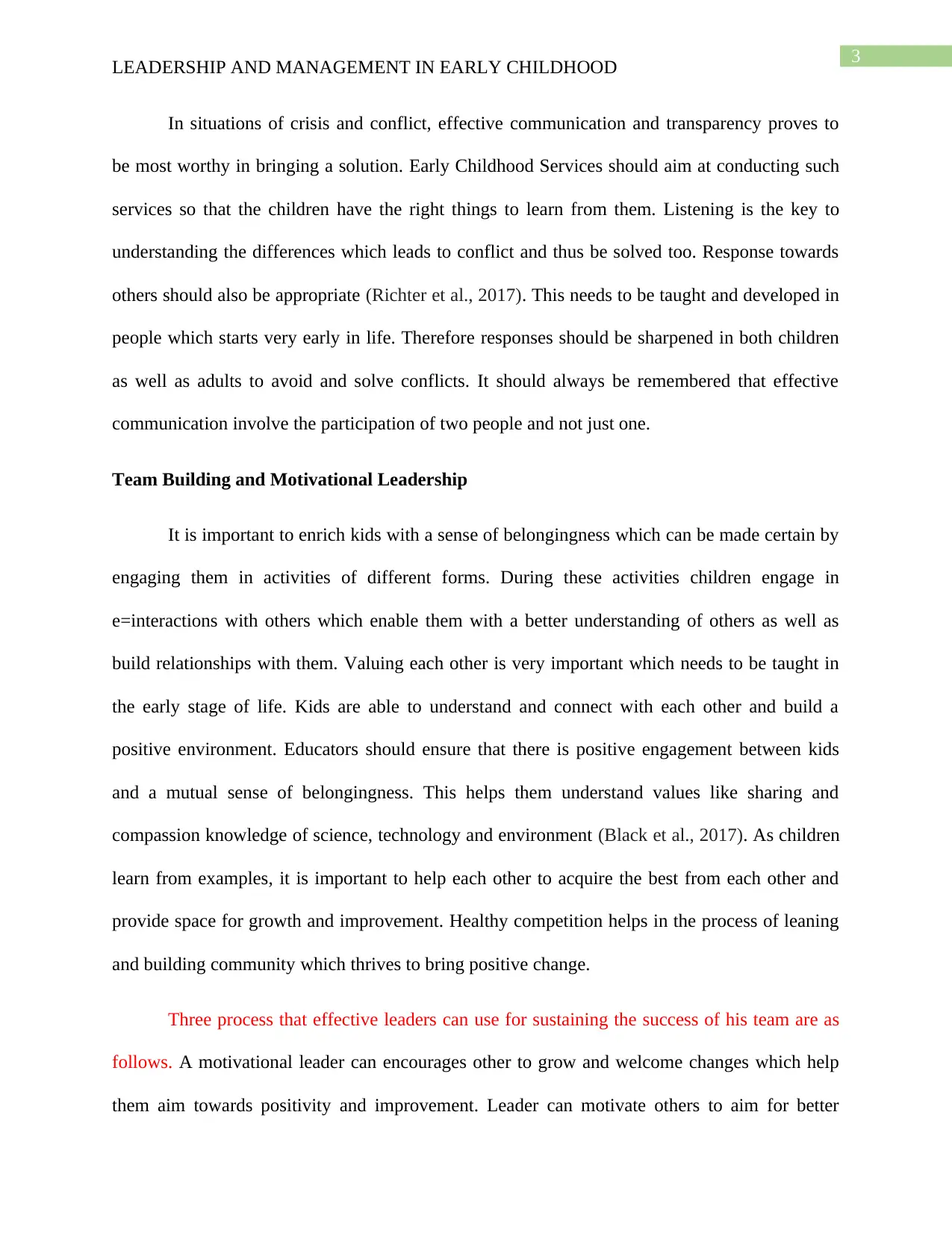
3
LEADERSHIP AND MANAGEMENT IN EARLY CHILDHOOD
In situations of crisis and conflict, effective communication and transparency proves to
be most worthy in bringing a solution. Early Childhood Services should aim at conducting such
services so that the children have the right things to learn from them. Listening is the key to
understanding the differences which leads to conflict and thus be solved too. Response towards
others should also be appropriate (Richter et al., 2017). This needs to be taught and developed in
people which starts very early in life. Therefore responses should be sharpened in both children
as well as adults to avoid and solve conflicts. It should always be remembered that effective
communication involve the participation of two people and not just one.
Team Building and Motivational Leadership
It is important to enrich kids with a sense of belongingness which can be made certain by
engaging them in activities of different forms. During these activities children engage in
e=interactions with others which enable them with a better understanding of others as well as
build relationships with them. Valuing each other is very important which needs to be taught in
the early stage of life. Kids are able to understand and connect with each other and build a
positive environment. Educators should ensure that there is positive engagement between kids
and a mutual sense of belongingness. This helps them understand values like sharing and
compassion knowledge of science, technology and environment (Black et al., 2017). As children
learn from examples, it is important to help each other to acquire the best from each other and
provide space for growth and improvement. Healthy competition helps in the process of leaning
and building community which thrives to bring positive change.
Three process that effective leaders can use for sustaining the success of his team are as
follows. A motivational leader can encourages other to grow and welcome changes which help
them aim towards positivity and improvement. Leader can motivate others to aim for better
LEADERSHIP AND MANAGEMENT IN EARLY CHILDHOOD
In situations of crisis and conflict, effective communication and transparency proves to
be most worthy in bringing a solution. Early Childhood Services should aim at conducting such
services so that the children have the right things to learn from them. Listening is the key to
understanding the differences which leads to conflict and thus be solved too. Response towards
others should also be appropriate (Richter et al., 2017). This needs to be taught and developed in
people which starts very early in life. Therefore responses should be sharpened in both children
as well as adults to avoid and solve conflicts. It should always be remembered that effective
communication involve the participation of two people and not just one.
Team Building and Motivational Leadership
It is important to enrich kids with a sense of belongingness which can be made certain by
engaging them in activities of different forms. During these activities children engage in
e=interactions with others which enable them with a better understanding of others as well as
build relationships with them. Valuing each other is very important which needs to be taught in
the early stage of life. Kids are able to understand and connect with each other and build a
positive environment. Educators should ensure that there is positive engagement between kids
and a mutual sense of belongingness. This helps them understand values like sharing and
compassion knowledge of science, technology and environment (Black et al., 2017). As children
learn from examples, it is important to help each other to acquire the best from each other and
provide space for growth and improvement. Healthy competition helps in the process of leaning
and building community which thrives to bring positive change.
Three process that effective leaders can use for sustaining the success of his team are as
follows. A motivational leader can encourages other to grow and welcome changes which help
them aim towards positivity and improvement. Leader can motivate others to aim for better
Secure Best Marks with AI Grader
Need help grading? Try our AI Grader for instant feedback on your assignments.
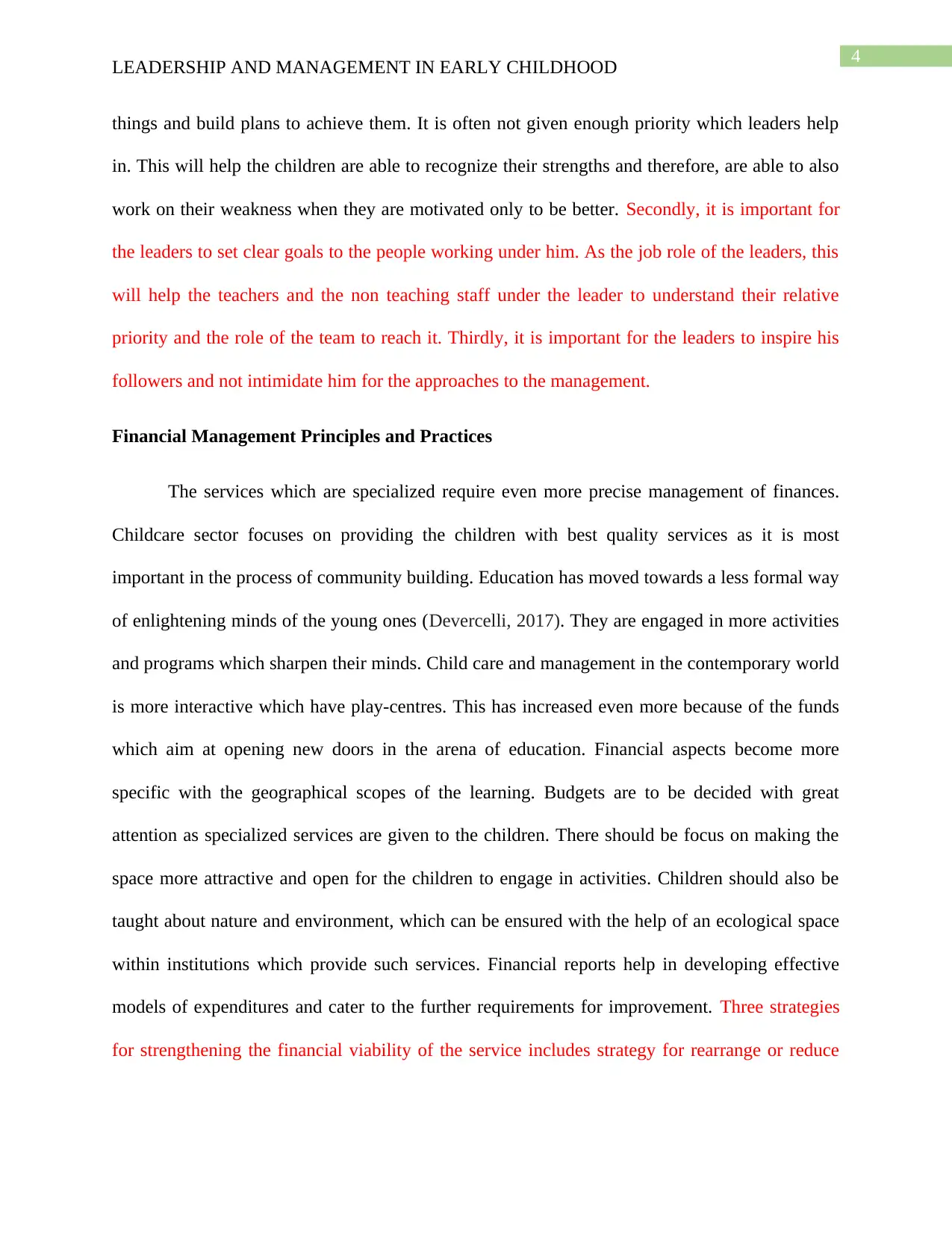
4
LEADERSHIP AND MANAGEMENT IN EARLY CHILDHOOD
things and build plans to achieve them. It is often not given enough priority which leaders help
in. This will help the children are able to recognize their strengths and therefore, are able to also
work on their weakness when they are motivated only to be better. Secondly, it is important for
the leaders to set clear goals to the people working under him. As the job role of the leaders, this
will help the teachers and the non teaching staff under the leader to understand their relative
priority and the role of the team to reach it. Thirdly, it is important for the leaders to inspire his
followers and not intimidate him for the approaches to the management.
Financial Management Principles and Practices
The services which are specialized require even more precise management of finances.
Childcare sector focuses on providing the children with best quality services as it is most
important in the process of community building. Education has moved towards a less formal way
of enlightening minds of the young ones (Devercelli, 2017). They are engaged in more activities
and programs which sharpen their minds. Child care and management in the contemporary world
is more interactive which have play-centres. This has increased even more because of the funds
which aim at opening new doors in the arena of education. Financial aspects become more
specific with the geographical scopes of the learning. Budgets are to be decided with great
attention as specialized services are given to the children. There should be focus on making the
space more attractive and open for the children to engage in activities. Children should also be
taught about nature and environment, which can be ensured with the help of an ecological space
within institutions which provide such services. Financial reports help in developing effective
models of expenditures and cater to the further requirements for improvement. Three strategies
for strengthening the financial viability of the service includes strategy for rearrange or reduce
LEADERSHIP AND MANAGEMENT IN EARLY CHILDHOOD
things and build plans to achieve them. It is often not given enough priority which leaders help
in. This will help the children are able to recognize their strengths and therefore, are able to also
work on their weakness when they are motivated only to be better. Secondly, it is important for
the leaders to set clear goals to the people working under him. As the job role of the leaders, this
will help the teachers and the non teaching staff under the leader to understand their relative
priority and the role of the team to reach it. Thirdly, it is important for the leaders to inspire his
followers and not intimidate him for the approaches to the management.
Financial Management Principles and Practices
The services which are specialized require even more precise management of finances.
Childcare sector focuses on providing the children with best quality services as it is most
important in the process of community building. Education has moved towards a less formal way
of enlightening minds of the young ones (Devercelli, 2017). They are engaged in more activities
and programs which sharpen their minds. Child care and management in the contemporary world
is more interactive which have play-centres. This has increased even more because of the funds
which aim at opening new doors in the arena of education. Financial aspects become more
specific with the geographical scopes of the learning. Budgets are to be decided with great
attention as specialized services are given to the children. There should be focus on making the
space more attractive and open for the children to engage in activities. Children should also be
taught about nature and environment, which can be ensured with the help of an ecological space
within institutions which provide such services. Financial reports help in developing effective
models of expenditures and cater to the further requirements for improvement. Three strategies
for strengthening the financial viability of the service includes strategy for rearrange or reduce
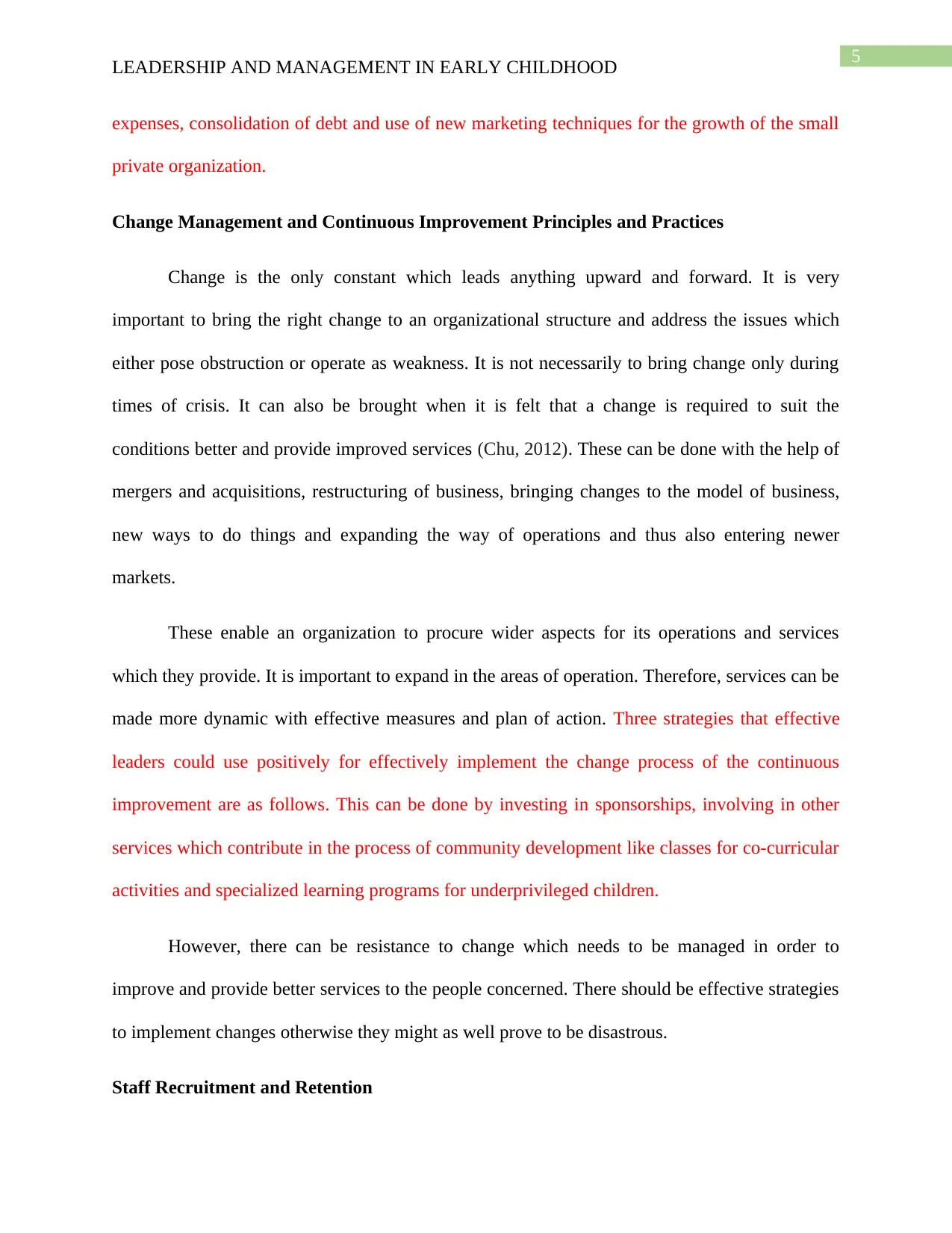
5
LEADERSHIP AND MANAGEMENT IN EARLY CHILDHOOD
expenses, consolidation of debt and use of new marketing techniques for the growth of the small
private organization.
Change Management and Continuous Improvement Principles and Practices
Change is the only constant which leads anything upward and forward. It is very
important to bring the right change to an organizational structure and address the issues which
either pose obstruction or operate as weakness. It is not necessarily to bring change only during
times of crisis. It can also be brought when it is felt that a change is required to suit the
conditions better and provide improved services (Chu, 2012). These can be done with the help of
mergers and acquisitions, restructuring of business, bringing changes to the model of business,
new ways to do things and expanding the way of operations and thus also entering newer
markets.
These enable an organization to procure wider aspects for its operations and services
which they provide. It is important to expand in the areas of operation. Therefore, services can be
made more dynamic with effective measures and plan of action. Three strategies that effective
leaders could use positively for effectively implement the change process of the continuous
improvement are as follows. This can be done by investing in sponsorships, involving in other
services which contribute in the process of community development like classes for co-curricular
activities and specialized learning programs for underprivileged children.
However, there can be resistance to change which needs to be managed in order to
improve and provide better services to the people concerned. There should be effective strategies
to implement changes otherwise they might as well prove to be disastrous.
Staff Recruitment and Retention
LEADERSHIP AND MANAGEMENT IN EARLY CHILDHOOD
expenses, consolidation of debt and use of new marketing techniques for the growth of the small
private organization.
Change Management and Continuous Improvement Principles and Practices
Change is the only constant which leads anything upward and forward. It is very
important to bring the right change to an organizational structure and address the issues which
either pose obstruction or operate as weakness. It is not necessarily to bring change only during
times of crisis. It can also be brought when it is felt that a change is required to suit the
conditions better and provide improved services (Chu, 2012). These can be done with the help of
mergers and acquisitions, restructuring of business, bringing changes to the model of business,
new ways to do things and expanding the way of operations and thus also entering newer
markets.
These enable an organization to procure wider aspects for its operations and services
which they provide. It is important to expand in the areas of operation. Therefore, services can be
made more dynamic with effective measures and plan of action. Three strategies that effective
leaders could use positively for effectively implement the change process of the continuous
improvement are as follows. This can be done by investing in sponsorships, involving in other
services which contribute in the process of community development like classes for co-curricular
activities and specialized learning programs for underprivileged children.
However, there can be resistance to change which needs to be managed in order to
improve and provide better services to the people concerned. There should be effective strategies
to implement changes otherwise they might as well prove to be disastrous.
Staff Recruitment and Retention
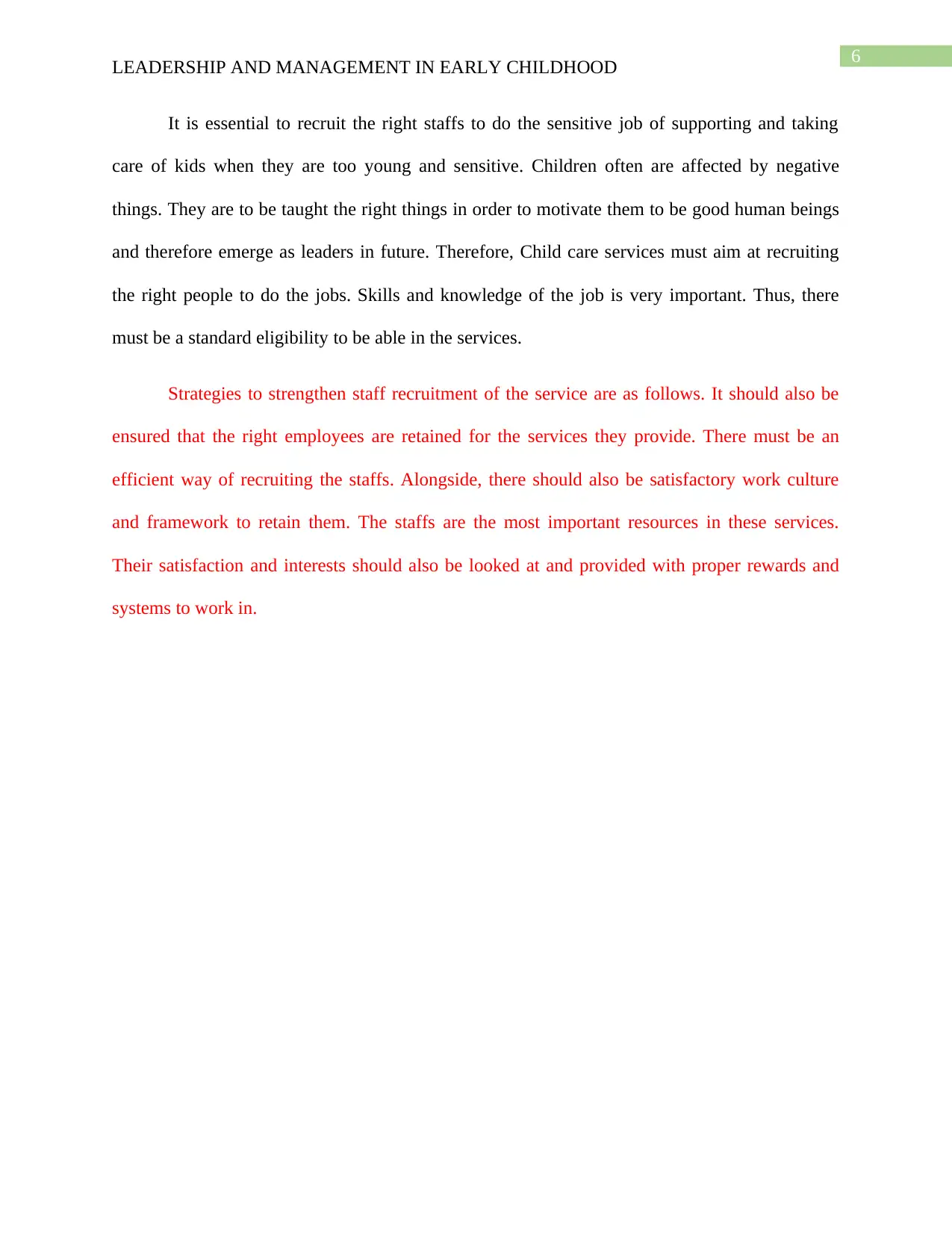
6
LEADERSHIP AND MANAGEMENT IN EARLY CHILDHOOD
It is essential to recruit the right staffs to do the sensitive job of supporting and taking
care of kids when they are too young and sensitive. Children often are affected by negative
things. They are to be taught the right things in order to motivate them to be good human beings
and therefore emerge as leaders in future. Therefore, Child care services must aim at recruiting
the right people to do the jobs. Skills and knowledge of the job is very important. Thus, there
must be a standard eligibility to be able in the services.
Strategies to strengthen staff recruitment of the service are as follows. It should also be
ensured that the right employees are retained for the services they provide. There must be an
efficient way of recruiting the staffs. Alongside, there should also be satisfactory work culture
and framework to retain them. The staffs are the most important resources in these services.
Their satisfaction and interests should also be looked at and provided with proper rewards and
systems to work in.
LEADERSHIP AND MANAGEMENT IN EARLY CHILDHOOD
It is essential to recruit the right staffs to do the sensitive job of supporting and taking
care of kids when they are too young and sensitive. Children often are affected by negative
things. They are to be taught the right things in order to motivate them to be good human beings
and therefore emerge as leaders in future. Therefore, Child care services must aim at recruiting
the right people to do the jobs. Skills and knowledge of the job is very important. Thus, there
must be a standard eligibility to be able in the services.
Strategies to strengthen staff recruitment of the service are as follows. It should also be
ensured that the right employees are retained for the services they provide. There must be an
efficient way of recruiting the staffs. Alongside, there should also be satisfactory work culture
and framework to retain them. The staffs are the most important resources in these services.
Their satisfaction and interests should also be looked at and provided with proper rewards and
systems to work in.
Paraphrase This Document
Need a fresh take? Get an instant paraphrase of this document with our AI Paraphraser
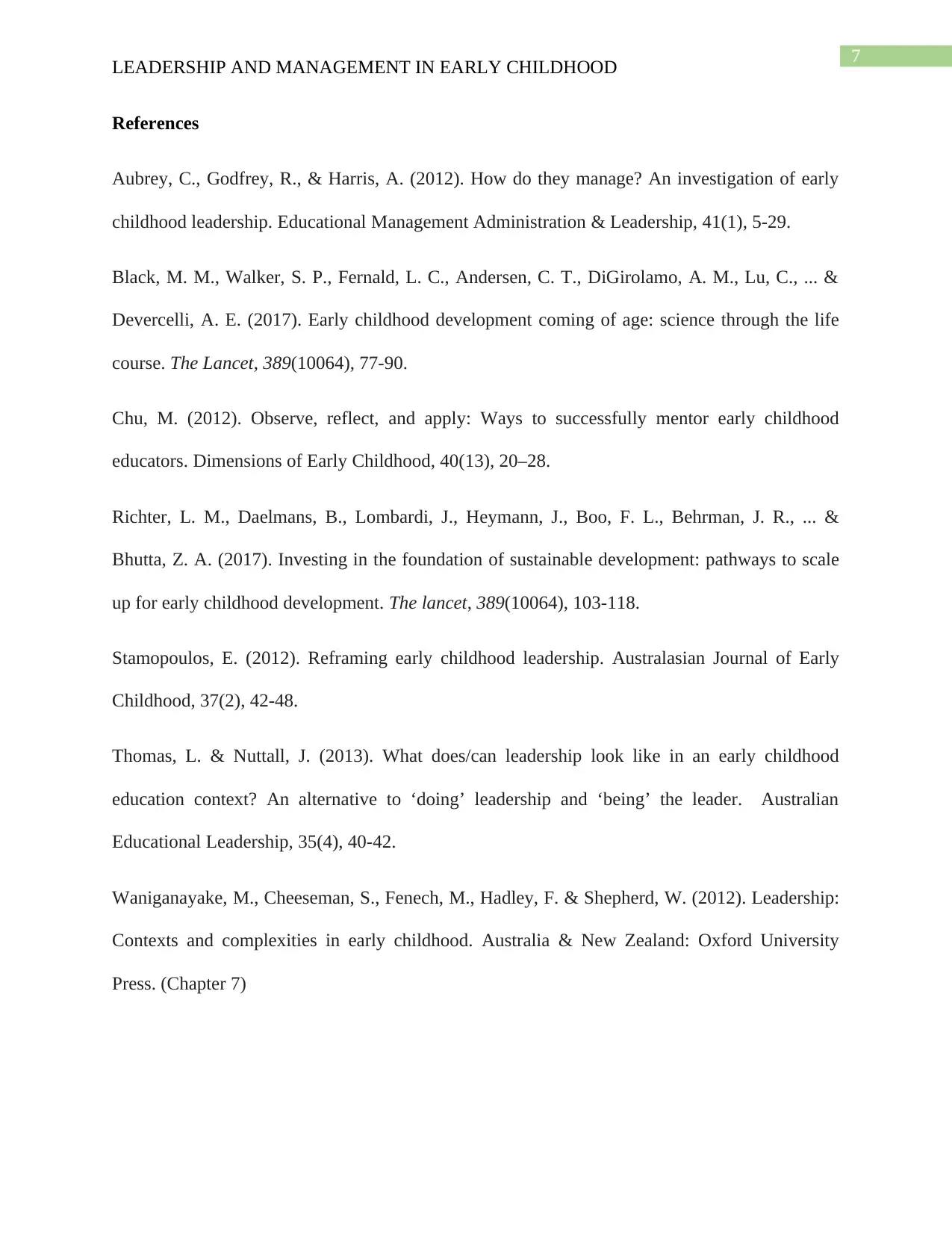
7
LEADERSHIP AND MANAGEMENT IN EARLY CHILDHOOD
References
Aubrey, C., Godfrey, R., & Harris, A. (2012). How do they manage? An investigation of early
childhood leadership. Educational Management Administration & Leadership, 41(1), 5-29.
Black, M. M., Walker, S. P., Fernald, L. C., Andersen, C. T., DiGirolamo, A. M., Lu, C., ... &
Devercelli, A. E. (2017). Early childhood development coming of age: science through the life
course. The Lancet, 389(10064), 77-90.
Chu, M. (2012). Observe, reflect, and apply: Ways to successfully mentor early childhood
educators. Dimensions of Early Childhood, 40(13), 20–28.
Richter, L. M., Daelmans, B., Lombardi, J., Heymann, J., Boo, F. L., Behrman, J. R., ... &
Bhutta, Z. A. (2017). Investing in the foundation of sustainable development: pathways to scale
up for early childhood development. The lancet, 389(10064), 103-118.
Stamopoulos, E. (2012). Reframing early childhood leadership. Australasian Journal of Early
Childhood, 37(2), 42-48.
Thomas, L. & Nuttall, J. (2013). What does/can leadership look like in an early childhood
education context? An alternative to ‘doing’ leadership and ‘being’ the leader. Australian
Educational Leadership, 35(4), 40-42.
Waniganayake, M., Cheeseman, S., Fenech, M., Hadley, F. & Shepherd, W. (2012). Leadership:
Contexts and complexities in early childhood. Australia & New Zealand: Oxford University
Press. (Chapter 7)
LEADERSHIP AND MANAGEMENT IN EARLY CHILDHOOD
References
Aubrey, C., Godfrey, R., & Harris, A. (2012). How do they manage? An investigation of early
childhood leadership. Educational Management Administration & Leadership, 41(1), 5-29.
Black, M. M., Walker, S. P., Fernald, L. C., Andersen, C. T., DiGirolamo, A. M., Lu, C., ... &
Devercelli, A. E. (2017). Early childhood development coming of age: science through the life
course. The Lancet, 389(10064), 77-90.
Chu, M. (2012). Observe, reflect, and apply: Ways to successfully mentor early childhood
educators. Dimensions of Early Childhood, 40(13), 20–28.
Richter, L. M., Daelmans, B., Lombardi, J., Heymann, J., Boo, F. L., Behrman, J. R., ... &
Bhutta, Z. A. (2017). Investing in the foundation of sustainable development: pathways to scale
up for early childhood development. The lancet, 389(10064), 103-118.
Stamopoulos, E. (2012). Reframing early childhood leadership. Australasian Journal of Early
Childhood, 37(2), 42-48.
Thomas, L. & Nuttall, J. (2013). What does/can leadership look like in an early childhood
education context? An alternative to ‘doing’ leadership and ‘being’ the leader. Australian
Educational Leadership, 35(4), 40-42.
Waniganayake, M., Cheeseman, S., Fenech, M., Hadley, F. & Shepherd, W. (2012). Leadership:
Contexts and complexities in early childhood. Australia & New Zealand: Oxford University
Press. (Chapter 7)
1 out of 8
Related Documents
Your All-in-One AI-Powered Toolkit for Academic Success.
+13062052269
info@desklib.com
Available 24*7 on WhatsApp / Email
![[object Object]](/_next/static/media/star-bottom.7253800d.svg)
Unlock your academic potential
© 2024 | Zucol Services PVT LTD | All rights reserved.





